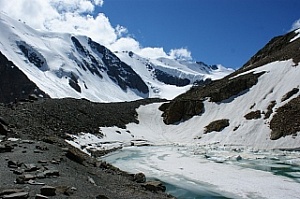The TSU Siberian Institute of the Future (StrAU TSSW) has begun to create an information platform that accumulates data on the resources of Siberia as a macroregion. The first three blocks are scheduled for implementation in 2019: climate change and forecast models, a digital herbarium, and literary heritage. In the future, the platform can be used for study and work, for example, to carry out research projects.
- The digital model of Siberia will consist of big data blocks that will be placed at the TSU supercomputer SKIF-Cyberia. One of the platform sections is associated with the transformation of the environment of the Siberian Federal Okrug, - says Ludmila Borilo, director of the TSSW. - The international network of SecNet stations, created by TSU for the study of Siberia, annually gives us a large amount of information that can be useful not only to researchers but also to many other specialists. For example, data on ground movements due to permafrost thawing are important for construction companies in the Arctic.
In the process of completing the platform, the TSSW will collaborate with various research centers and academic institutions. For example, with the Institute for Monitoring Climate and Ecological Systems (IMCES) of the Siberian Branch of the Russian Academy of Sciences, scientists plan to improve the forecast models. The collection of data that researchers will gather based on the technical specifications of developers will help to improve forecast accuracy.
- Most models do not take into account the details, which can lead to significant errors,- explains Lyudmila Borilo. - So, the average water body is usually included in the calculation algorithm; there is no such thing as a river in the model. But in predicting natural phenomena, such as greenhouse gas emissions, the presence of a current is of great importance, since it contributes to an increase in emissions. We want to achieve maximum forecast accuracy by combining mathematical models, which are very well built by IMCES specialists, with our digital landscape maps.
Platform luggage will be constantly updated with new information. The results of the processed materials can be used by other researchers. For example, glaciologists can get acquainted with the latest information about melting glaciers, which are studied by the staff of the TSU Faculty of Geology and Geography. Many Russian and international researchers will be interested in the information collected by TSU scientists about rivers, swamps, and lakes in Siberia, including the largest bodies of water in the world - the Ob and the Vasyugan Swamp. Over time, the platform could become a space for the formation of new research projects related to the study of the macroregion.
Along with this, the TSU information hub will be useful for solving practical problems of Tomsk and adjacent regions. It will help to calculate the risks associated with the spring flood and to predict the yield of wild plants.
In 2019, the platform will be replenished with two more blocks, except for the forecast one. One of them will include the digitized resources of the TSU Research Library, where 7,700,596 documents are stored. Another block is the digitized materials of the TSU Herbarium, collected by university scientists for more than 100 years, now among the three largest herbariums in Russia.
In the future, the platform will expand with new blocks dedicated to the soil resources of Siberia, bodies of water, and biodiversity. It is also planned to host the educational resource Virtual Arctic, which TSU is working on in conjunction with the University of Sheffield (Great Britain) and the University of Oulu (Finland). A new English-language resource using different types of visualization - computer animation, 3D-tours, infographics, and other tools will acquaint visitors with the Arctic, turning the results of scientific research into a tool for self-education and expanding knowledge in various educational programs.

